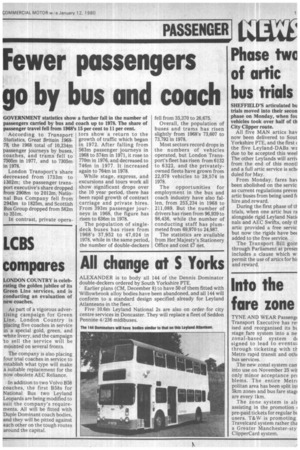Fewer passengers go by bus and coach
Page 21

If you've noticed an error in this article please click here to report it so we can fix it.
GOVERNMENT statistics show passengers carried by bus and c passenger travel fell from 1968's According to Transport Statistics, Great Britain 196878, the 1968 total of 10,234m passenger journeys by buses, coaches, and trams fell to 7505m in 1977, and to 7305m in 1978.
London Transport's share decreased from 1733m to 1302m; the passenger transport executive's share dropped from 2908m to 2012m, Natiohal Bus Company fell from 2943m to 1825m, and Scottish Bus Group dropped from 582m to 351m.
In contrast, private opera a further fall in the number of oach up to 1978. The share of 15 per cent to 11 per cent.
tors show a return to the growth of traffic which began in 1972. After falling from 563m passenger journeys in 1968 to 574m in 1971, it rose to 770m in 1976, and decreased to 746m in 1977. It increased again to 764m in 1978.
While stage, express, and excursions and tours work all show significant drops over the 10 year period, there has been rapid growth of contract carriage and private hires. From 393m passenger journeys in 1968, the figure has risen to 636m in 1978.
The population of singledeck buses has risen from 1968's 37,952 to 47,024 in 1978, while in the same period,. the number of double-deckers fell from 35,370 to 26,675.
Overall, the population of buses and trams has risen slightly from 1968's 73,607 to 73,792 in 1978.
Most sectors record drops in the numbers of vehicles operated, but London Transport's fleet has risen from 6132 to 6322, and the privatelyowned fleets have grown from 22,078 vehicles to 28,574 in 1978.
The opportunities for employment in the bus and coach industry have also fallen, from 253,234 in 1968 to 211,089. But the number of drivers has risen from 96,939 to 98,436, while the number of conducting staff has plummeted from 69,970 to 24,987.
The statistics are available from Her Majesty's Stationery Office and cost E7 net.












































































































